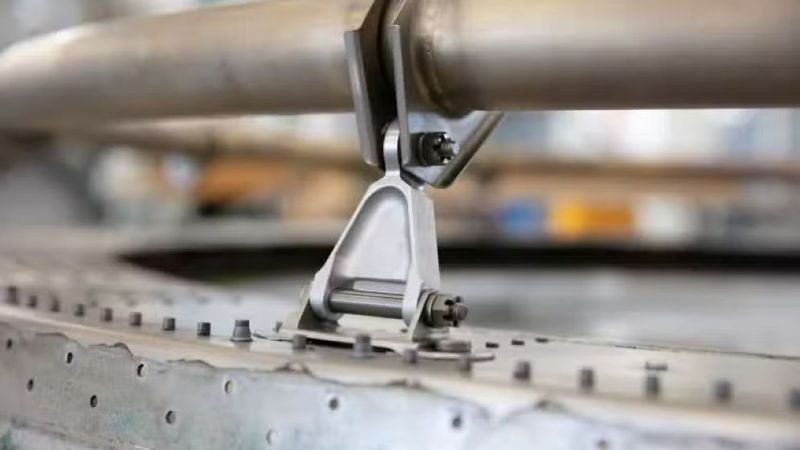The Metal 3D Printing Technology Report: Chapter 5: Applications of Metal Additive Manufacturing
This chapter of the report will lay out and examine the various applications of metal additive manufacturing, with a particular focus on end-use applications in the dominant metal AM adoption industries.
Understand the Future of Metal 3D Printing
The Metal 3D Printing Technology Report is your essential guide to the latest advances, applications, and real-world insights into additive manufacturing with metal. Packed with detailed case studies, practical information, and interviews with industry leaders, this report reveals how metal 3D printing is transforming industries and pushing the boundaries of manufacturing.
Read the intro to the report here and an excerpt from chapter 5 below.
Complete this form and get your report in your inbox
This chapter will explore the multifaceted applications of metal additive manufacturing (AM), emphasizing its transformative impact on end-use production within the three leading sectors of Aerospace, Automotive, and Medical industries.
Initially, it is crucial to address the broader, industry-agnostic benefits that metal AM offers across various facets of manufacturing. These include enhancements in product development cycles through rapid prototyping, which accelerates time-to-market by allowing for swift iterations of design prototypes. Additionally, metal AM is instrumental in the creation of specialized tooling and production aids, which can be customized to unique specifications without the constraints of conventional tooling costs or lead times.
Furthermore, metal AM excels in the production of high-performance, end-use parts that meet stringent industry standards and can be optimized for weight, strength, and functionality. The technology's capacity for producing low-volume, high-value components is particularly advantageous in sectors like aerospace and medical, where customization and performance are critical. Lastly, the maintenance and repair operations (MRO) aspect of metal AM showcases its ability to extend the lifecycle of parts through effective repair processes and the on-demand manufacturing of replacement parts, thus reducing downtime and inventory costs.
Through detailed examination, this chapter will delineate how these capabilities are being leveraged within the targeted industries to drive innovation, improve efficiency, and reduce costs, thereby solidifying metal AM's role as a cornerstone of modern manufacturing strategies.
Product Development | One of the original applications for metal additive manufacturing was prototyping, as it enables the direct production of single parts or small batches in a more economical way than conventional manufacturing processes. Today, the technology is still used for prototyping, empowering manufacturers to accelerate product development cycles and improve the function and performance of end-use parts. For example, aerospace engineers can 3D print a metal prototype for an aircraft bracket and test that component for fit and function, if any design changes are required to improve part performance, it is possible to go back to the CAD file to make changes and print the next iteration, without having to invest in costly tooling. |
Tooling and Production Aids | Additive manufacturing technologies have dramatically simplified the production of tooling and production aids. For example, manufacturers are benefiting from the ability to 3D print casting molds and hot stamping tools with conformal cooling channels to actually improve the casting process and extend tool lifetime. Nikon SLM Solutions, for example, has recorded 75% faster cycle times using its metal 3D printed molds compared to conventional tool production processes, as well as higher quality final parts. |
Optimized/Custom End-Use Parts | The design freedom made possible by additive manufacturing techniques has had a significant impact in the design and production of more efficient, higher performing metal parts. Manufacturers in spheres like aerospace have been able to design more lightweight and efficient systems using intelligent design solutions, which unlock greater fuel efficiency, while the medical sector has benefited from the ability to 3D print implants with porous internal structures to improve bio-regeneration—something that would be impossible using subtractive manufacturing techniques. Metal AM has also offered unprecedented customization opportunities for end-use parts and products. |
Maintenance, Repair, and Operations (MRO) | Metal additive manufacturing technologies have been transformative for maintenance and repair operations in industries like aerospace, defense, maritime, automotive, and industrial manufacturing. AM has various use cases in this area. For example, DED processes are used to directly repair damaged metal parts, which is more economical than replacing them. Other metal AM technologies can rapidly iterate replacement parts at the time of need, eliminating the need for extensive inventories of spare parts, or can rapidly produce temporary parts to minimize downtimes while a permanent part is sourced. In some cases, metal AM can actually extend the lifespan of legacy systems, as obsolete parts can be 3D scanned or reverse engineered and 3D printed anew. Ultimately, metal AM streamlines MRO and can dramatically accelerate procurement times. |
Aerospace applications of metal AM
The aerospace industry has been a key adopter of metal additive manufacturing since the technology’s advent and has helped drive the evolution of various metal AM processes. When we talk about aerospace, we are referring to a fairly broad industry that comprises commercial aviation, defense aircraft, as well as space launch systems. In all these areas, the integration of metal additive manufacturing technologies has been driven by a few key factors, including:
Reduction in production costs for one-off or small series parts
Minimized lead times for system development, testing, and validation
Production agility for on-demand manufacturing and simplified inventories
Optimized design for weight reduction, fuel efficiency, and performance
Design consolidation for streamlined assembly processes and weight reduction
Generally speaking, metal AM is a good match for the needs of aerospace manufacturers, who benefit from an economical way to produce one-off or small batches of highly complex parts. Additive manufacturing also enables aerospace end users to address the fuel efficiency of aircraft and other flight systems by designing parts that are optimized for weight reduction, both through intelligent design solutions and through part consolidation, which not only helps reduce weight but also simplifies assembly processes further down the line. Furthermore, AM systems can process aerospace-grade materials with excellent strength-to-weight ratios, like titanium alloys, which are challenging to process using subtractive methods like CNC machining.
Today, metal additive manufacturing technologies have many uses in the aerospace sector, and many 3D printed parts are already in use both in production environments and in the air. Among the most widespread applications in the aerospace segment are:
Engine parts
One of the most impactful applications for metal AM in aerospace has been the production of high-performance aircraft and spacecraft engines. Across the industry, metal 3D printing has been used to redesign and consolidate engine parts, including turbine blades, inducers, impellers, engine fuel nozzles, and more. One of the most high-profile use cases comes from GE Aerospace, which received FAA approval for its GE9X engine that integrates over 300 3D printed components. The engine, the largest and most powerful commercial aircraft engine, offers a 5% fuel consumption improvement compared to other twin-aisle engines.
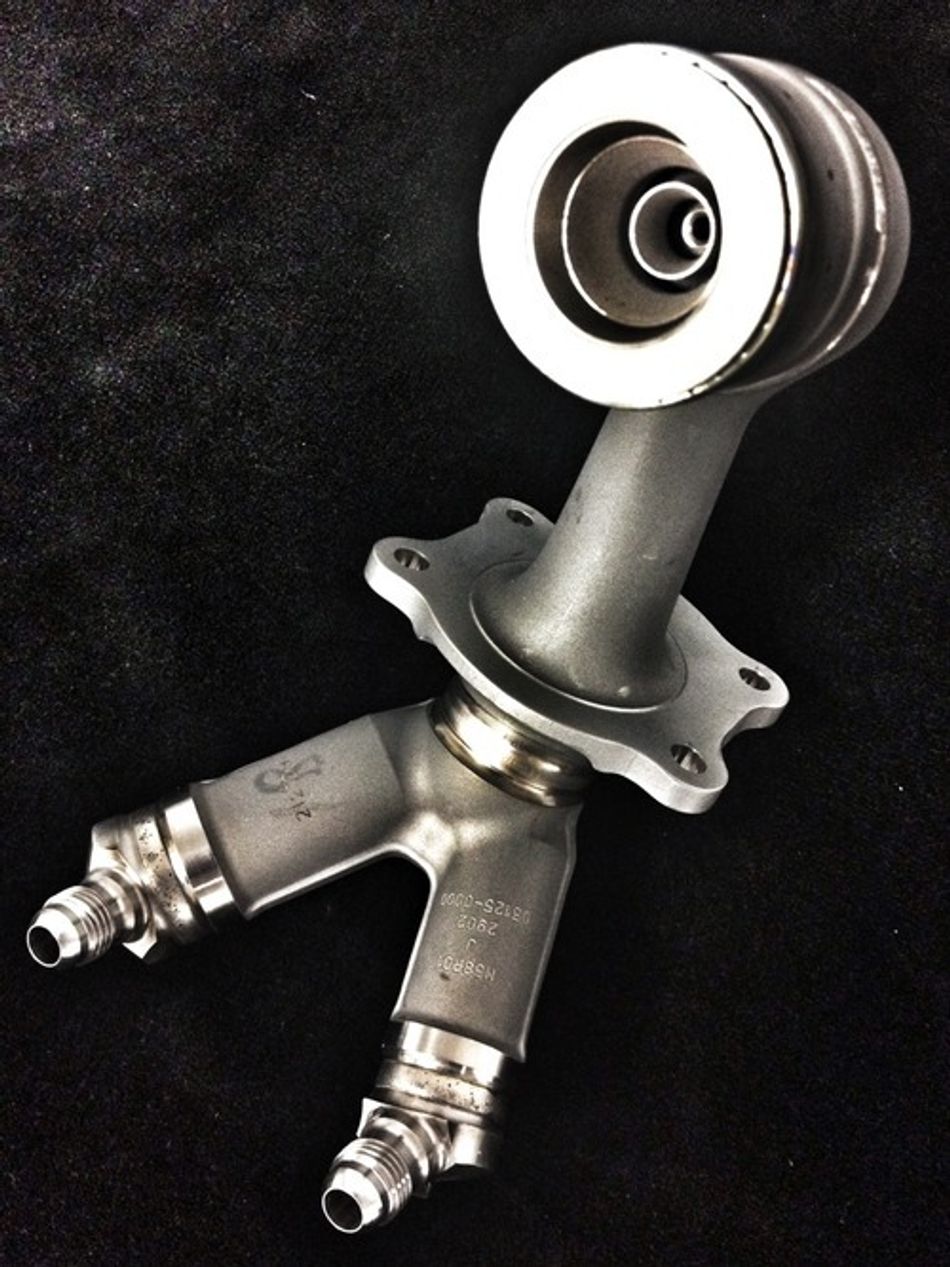
Brackets
Functional parts like nacelle hinge brackets, cabin brackets, reflector brackets, antenna brackets and more are benefiting from advanced design solutions, like topology optimization, and additive manufacturing. Through design optimization and the use of titanium alloys, aerospace OEMs have reduced bracket part weight while simultaneously improving performance, thus contributing to superior fuel efficiency. The benefits of weight reduction, even for smaller components like brackets, can add up: it is estimated that a 1% reduction in aircraft weight can lead to 0.75% savings in fuel.
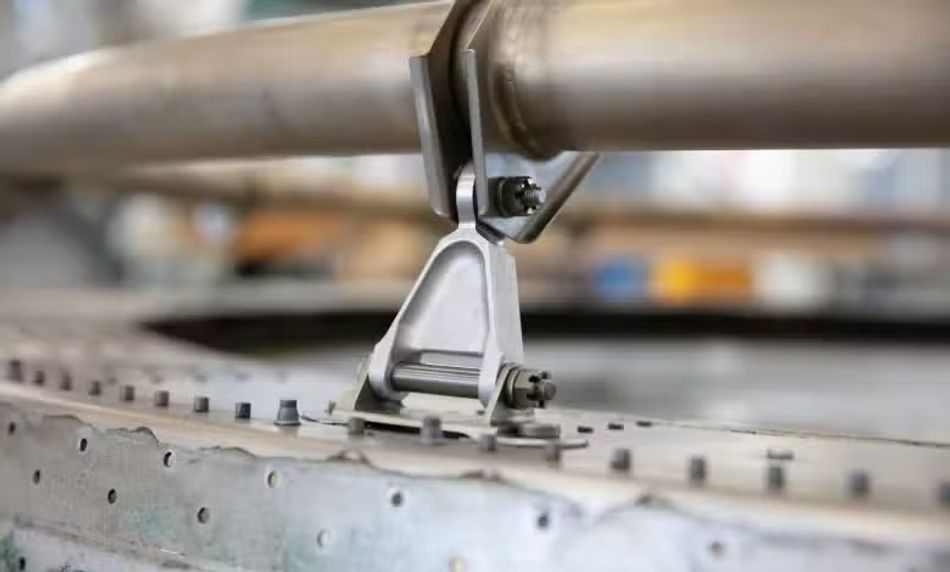
Satellite components
Metal AM is also increasingly being used in the development and production of satellite systems and components, which benefit from the technology’s production agility, customization, and ability to produce complex designs from robust metals that can withstand in-space environments. Boeing, for example, has been able to accelerate the development of the U.S. military’s Wideband Global Satcom (WGS) satellite through the integration of thousands of 3D printed components made from aluminum and titanium alloys. The project, which would typically take up to 10 years using more traditional methods, is expected to be completed in five.
MRO components
Maintenance, repair and operations (MRO) services are taking advantage of metal additive manufacturing for a range of applications. Metal AM technologies like DED are being used to directly repair aircraft components, such as turbine engine blades. In some cases, aerospace end users have achieved cost savings of up to 90% by turning to AM to repair blisks or turbine blades. Metal AM also enables the on-demand production of spare parts, which can extend the lifespan of legacy aircraft systems that may otherwise be grounded for lack of an obsolete part. While this application area is still somewhat nascent, in part due to the stringent regulations in the aerospace segment, there is huge potential for AM to revolutionize MRO processes for the better. We’ve already seen evidence of this: Lufthansa Technik and Premium AEROTEC successfully 3D printed a metal A-Link replacement part for an anti-icing system, which received an official aviation certification from EASA.
Space launch systems
Metal AM has proven indispensable in the ever-evolving space industry, playing an essential role in ushering in a new era of space launch systems. In this application area, metal AM allows space companies to dramatically speed up the development of new spacecraft, as well as to develop more lightweight and fuel-efficient rockets through design optimization and consolidation. Today there are a number of 3D printed rockets, primarily satellite launch vehicles, which have already been test-launched or are nearing launch readiness. In March 2023, for instance, Relativity Space, which operates its own large-scale metal 3D printing solution, successfully test-launched the Terran 1, which is 85% 3D printed by mass, with nine 3D printed engines.
In-space part production
At the very cutting edge of metal additive manufacturing is in-space part production. While polymer 3D printing in space has been possible since 2014, when Made In Space deployed a 3D printer to the International Space Station, metal 3D printing in space is a very recent milestone. In early 2024, the first metal 3D printer for space, which was developed by Airbus for the European Space Agency, was sent to the ISS, and in June 2024 the machine printed its first test part. Eventually, it will be used to print tools or mounting interfaces. It will also be used to better understand the potential of metal 3D printing on the Moon.
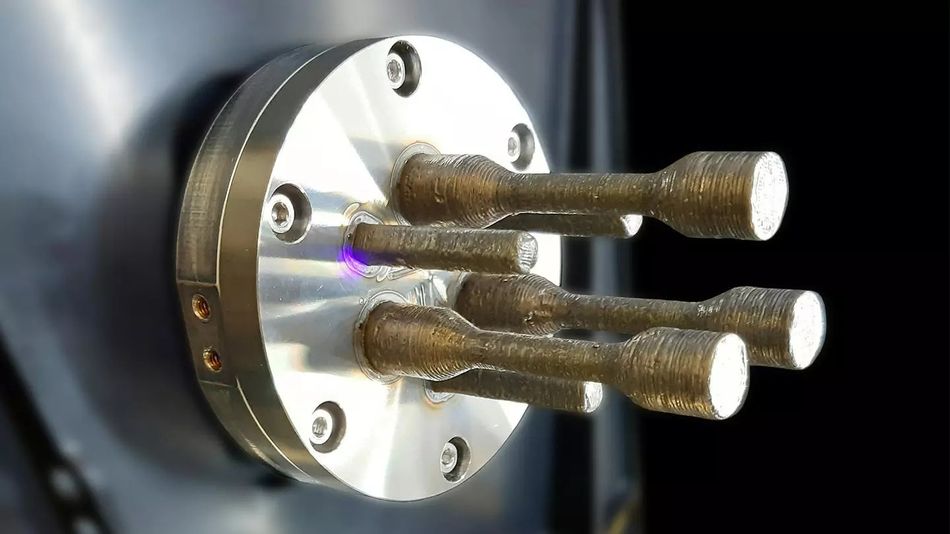
Medical applications of metal AM
The healthcare segment has been invested in additive manufacturing since the early days of the technology. This interest has primarily been driven by the need for greater customization in medical devices and instruments to improve medical procedures and, above all, patient outcomes. Additive manufacturing technologies are uniquely positioned to economically produce bespoke products and can be used in combination with existing medical technologies, such as CT scanning, to make implants and other medical devices tailored to a patient’s anatomy. In addition to 3D printing’s propensity for customization, there are also drivers of metal AM’s adoption in the medical industry, such as:
Optimization using design features like porous structures and lattices for better biointegration of implants
Mass customization for superior patient fit compared to off-the-shelf medical devices
Delivering complex geometries for biocompatible metals like titanium that are challenging to machine
Point-of-care production for faster delivery times and streamlined supply chains
As AM technologies and materials have matured over the years, the healthcare additive manufacturing market has been growing steadily. In 2024, the global healthcare AM market (comprising both polymers and metals) is valued at $10.95 billion, up from $ 9 billion in 2023. Within this, polymer AM still represents the greatest revenue share (55%), however metal AM has been making gains in large part due to the continued proliferation of metal implants.
On the horizon for metal AM in healthcare is greater adoption and standardization. Understandably manufacturing standards and requirements in the medical sector are stringent, and as AM itself becomes more standardized the frameworks for approving 3D printed medical devices will evolve. Currently, there are a number of FDA-approved (510(k) non-customized 3D printed implants on the market, however the approval process for custom implants is slightly different, requiring each new medical device to undergo FDA approval. On this front, the FDA has issued an initial framework that covers how it will regulate 3D printed devices manufactured at the point of care, however public policy groups have said this could benefit from greater clarity.
Below are some of the leading application groups for metal AM in the medical sector:
Dental prosthetics
Metal additive manufacturing is transforming how dental labs are designing and producing dental prosthetics including crowns and bridges, removable partial dentures (RPDs), implant bars, implant frames, and more. Previously many of these dental prosthetics were manufactured using casting or milling, which are time-consuming and costly. Metal AM, by contrast, can rapidly produce multiple custom prosthetics in a single build and dramatically simplify production preparation thanks to the digital process chain. For example, using a dual laser system with a 100 mm diameter build plate, it is possible to produce 100 crowns in just three hours. Metal LPBF is the dominant metal AM process used in the dental segment, as it allows for high precision, high productivity, and minimal post-processing. Common metals used for dental applications include cobalt-chromium and titanium.
Standardized orthopedic implants
Metal additive manufacturing is increasingly being used in the manufacture of orthopedic implants—including spinal implants and knee replacements—which are used to treat broken or damaged joints and bones. In fact, there are a number of implant manufacturers that are integrating metal AM in their product development and series production to improve functionality through DfAM. Medical tech company Stryker is among those leading the way, having reportedly 3D printed more than two million metal implants in the past decade. From a design perspective, metal AM enables the production of implants with complex porous structures, which are not only more lightweight, but actually encourage osseointegration within the body. From a production standpoint, advanced orthopedic implants can be manufactured more efficiently, with no tooling costs and minimal to no assembly time.
Patient-specific implants (PSIs)
Arguably one of the most disruptive applications in the medical sector for metal additive manufacturing is in the production of patient-specific implants, which are designed based on patient data. Patient-specific implants have several advantages over standard ones, such as optimal fit and comfort for the patient, superior alignment in the body, and shorter operation times, which can result in minimized risk and faster recovery. Currently, 3D printed PSIs are most common in particularly complex cases. For example, the Hospital for Special Surgery (HSS) in New York has an in-house 3D printing lab where it produces patient-specific joint replacements using biocompatible titanium. Other areas where 3D printed PSI technology are advancing are cranial implants and maxillo-facial reconstruction. While the technology is currently able to produce high-quality custom implants, the main challenge to rolling out 3D printed PSIs is related to regulatory issues.

Medical instruments
In addition to various types of implants, metal AM is also valuable in the medical sector for the production of surgical instruments and devices, including patient-specific surgical cutting guides and drilling guides. The quality and functionality of surgical instruments are vital to the success and efficiency of procedures, so having instruments customized to the surgeon's needs and patient’s anatomy can contribute to more seamless operations and thus outcomes. Biocompatible metals like titanium and stainless steel are used to prototype and ultimately manufacture single-use instruments with high precision. Design optimization can also be employed to create more lightweight and ergonomic surgical tools that facilitate procedures, particularly valuable in long surgeries.
Automotive applications of metal AM
While the majority of automotive additive manufacturing applications utilize polymer-based technologies—with polymer AM products representing 69% of AM automotive revenues in 2023 and metal AM products 31%—metal additive is still a critical manufacturing technology in this vertical that is used for a range of applications, including prototyping and product development, tooling, and custom and specialty part production (series or mass production applications for metal AM in automotive are still very limited). The integration of additive manufacturing in these automotive areas is driven by the technology’s following capabilities:
Accelerating product development and innovation cycles through prototyping
Optimizing design for fuel efficiency and performance in hypercars or specialty vehicles
Economically producing one-off parts for restoration or customization
Facilitating production agility through custom tooling
Metal AM’s proliferation in the automotive sector has been more limited than in the aerospace and medical industries due to the scale of production required and the cost of parts. Metal AM, which is still most advantageous for the production of one-off or small volumes of highly complex parts, has therefore been limited in terms of end-use production to high-performance or cutting-edge automotive applications—some of which are described below. However, as scalability and mass production become more viable for metal AM through lowering metal powder costs and the maturation of scalable and economical metal binder jetting, there is potential for series production metal AM applications to take off in automotive.
Below are some of the current key applications for metal AM in automotive:
Powertrain and chassis
A number of automotive manufacturers have leveraged metal AM in the development and production of automotive chassis and powertrain components, including engines, E-drive housings, cylinder blocks, and more. In this area, many use cases are proof of concepts, such as the E-drive housing 3D printed by Porsche using the SLM Solutions NXG XII 600. Production applications are largely limited to specialized vehicles, such as hypercars. For example, the Bugatti Tourbillon hypercar will feature a 3D printed chassis and suspension made using automotive AM pioneer Divergent’s DAPS metal AM technology. The structural components result in weight reduction and performance enhancements.
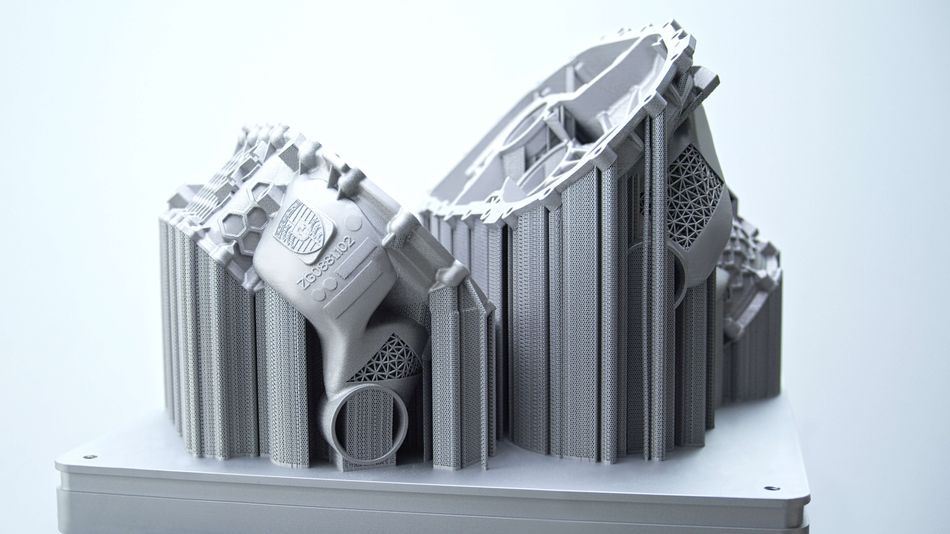
Vehicle Restoration
An application where the use of metal additive manufacturing is flourishing is in the production of obsolete or hard-to-source spare parts for vintage or aging cars. Leveraging 3D scanning or reverse engineering, automotive specialists can bring older car models back to life by replacing damaged components with high-quality metal 3D prints. Metal AM provides a rapid and economical way to produce small batches of parts. For example, Porsche Classic uses metal LPBF to reproduce a number of spare parts whose stocks have been depleted, such as a release level for the clutch of the Porsche 959. Metal AM is also gaining traction in the world of collision repair.
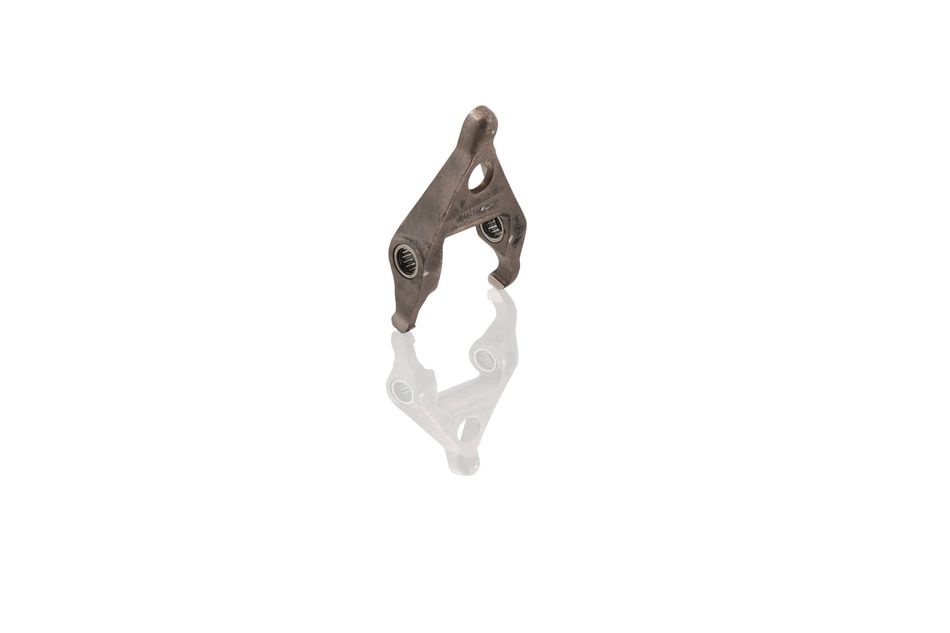
EV parts
In the electric vehicle (EV) market, metal AM brings many of the same benefits as conventional automotive manufacturing, like faster development cycles, and the production of more lightweight parts (which in this case benefits mileage per battery charge, not fuel consumption). While production applications in EVs are not ubiquitous, there are recent use cases to highlight, including XPeng Motors’ use of BLT’s metal 3D printing in the production of brake calipers for its EVs. Other innovative uses of metal AM in the EV market, which could transform EV production in the future, are the manufacturing of electric motors and more compact solid-state batteries.
Motorsport
The motorsport industry has been a keen adopter of metal AM for obvious reasons: the technology is well suited to reducing the weight of parts, creating complex designs for high-performance applications, and enabling rapid development. In motorsport, metal AM has been used for various applications and has been well-established for nearly a decade. 3D printed parts integrated into Formula 1 cars include electronic component mounts, pistons, cooling circuit ducts, and chassis inserts. Metal AM is also being explored in more complex motorsport structures, such as heat exchangers, thanks to process advances and material qualifications.
Tooling
While production applications for metal AM in automotive are still limited to specialty areas, the technology has found its place in the context of existing production workflows for tooling, molds, and other production aids. The technology has unlocked significant cost and time savings. At Volkswagen, the automotive manufacturer achieved 650% cost reduction by 3D printing a 316L stainless steel tooling nozzle in the mass production of the VW Tiguan. AM design features, like conformal cooling channels integrated into tooling, can actually improve the output of traditional production processes.
Other metal AM adopter industries
Aerospace, medical, and automotive are three of the industries leading the adoption of metal AM processes, however, the technology is also making an impact in other areas, including energy, defense, and consumer goods.
In the energy industry, OEMs are leveraging metal AM to improve the functionality and efficiency of parts through intelligent design and part consolidation. Application examples include gas turbine nozzles, heat exchangers, pressure gauges, impellers, rotors, control valve components, flow meters, and more. Metal 3D printed parts can also help offshore energy organizations minimize system downtimes through the on-demand and on-site production of replacement parts.
In defense, metal AM is being explored for various maintenance and repair operations. The technology can be used to extend the lifetime of older machinery, such as aircraft, as well as to make repairs at the point of need. We are seeing the latter advance in navies around the world, as they realize the benefits of point-of-need production for naval vessel components using DED technologies.
In the consumer segment, metal AM is carving out a niche for itself in the sphere of luxury goods, like jewelry and watches. Additive manufacturing enables the creation of avant-garde designs, previously impossible to manufacture, as well as greater customization. By leveraging AM through the design and production stages, jewelry and watch makers can accelerate product development and minimize production costs by eliminating tooling.
UltiMaker expert Gasperini says: “Where we have seen unexpected interest was from consumer goods, for example watchmakers and design studios that are preparing bespoke objects. Our technology enables them to make metal parts internally without a high investment.”
Read an excerpt from the chapters here:
Introduction Chapter
The Metal 3D Printing Technology Report is your essential guide to the latest advances, applications, and real-world insights into additive manufacturing with metal.
In the first chapter of our new report, we examine the dominant methods of metal 3D printing—metal laser powder bed fusion (LPBF), directed energy deposition (DED), metal extrusion, and binder jetting—as well as other still-emerging or more niche processes.
The metal additive manufacturing market features various feedstock types, with powder being the dominant choice for LPBF, some DED methods, and binder jetting. Metal wire and bound metal filament are also used in specific technologies.
In this chapter, we separate metal AM post-processing into four categories: debinding and sintering, CNC machining and milling, heat treatment, and quality assurance.
Metal 3D printing offers significant design opportunities with its high geometrical freedom, but it requires careful design for additive manufacturing (DfAM) to address equipment and material constraints, a process supported by DfAM and 3D printing simulation tools in most major CAD software.
Chapter 5
This chapter of the report will lay out and examine the various applications of metal additive manufacturing, with a particular focus on end-use applications in the dominant metal AM adoption industries.


In this chapter, we present three exclusive interviews with industry experts from Xometry, UltiMaker, and Aibuild, key sponsors of the Wevolver Metal 3D Printing Technology Report.

